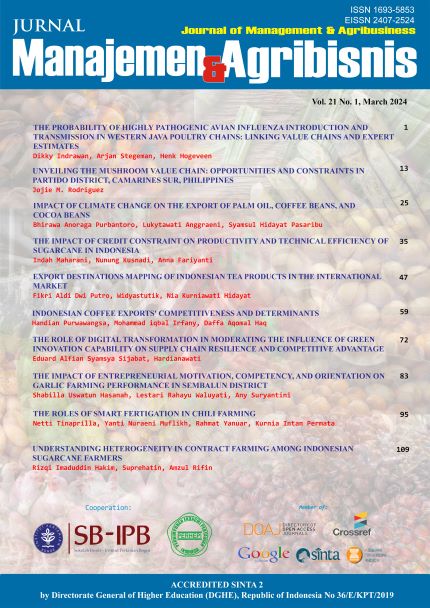Export Destinations Mapping of Indonesian Tea Products in The International Market
Abstract
Indonesian tea products have become an export-oriented commodity. However, Indonesian tea products trade performance, particularly the exports, has shown a persistent decline for the last decade (2012–2021). Therefore, this study aims to analyse the competitiveness of Indonesia tea products export as well as map the export destinations for Indonesia tea products. This study employs secondary data regarding tea product export value from UN Comtrade during the 2012–2021 period with analysis using revealed comparative advantage (RCA), export product dynamic (EPD), and X-model potential export product. The RCA results suggest that Indonesian tea products exhibit an overall strong comparative advantage in the international market, albeit still lagging behind India. Additionally, Indonesia also exhibits a strong comparative advantage in all tea products, except tea extract and preparation products. The EPD results show that Indonesia possesses a competitive advantage in packaged black tea, bulk green tea, also tea extract and preparation products. The export destination mapping reveals the 28 potential destinations serving as the focus for Indonesian tea export expansion. These potential destinations are dominated by the non-traditional.
Keywords: tea products export, EPD, potential destinations, RCA, X-model potential export product
Authors
Authors who publish with this journal agree to the following terms:
- Authors retain copyright and grant the journal right of first publication with the work simultaneously licensed under a Creative Commons Attribution License that allows others to share the work with an acknowledgement of the work's authorship and initial publication in this journal.
- Authors are able to enter into separate, additional contractual arrangements for the non-exclusive distribution of the journal's published version of the work (e.g., post it to an institutional repository or publish it in a book), with an acknowledgement of its initial publication in this journal.
- Authors are permitted and encouraged to post their work online (e.g., in institutional repositories or on their website) prior to and during the submission process, as it can lead to productive exchanges, as well as earlier and greater citation of published work (See The Effect of Open Access).

